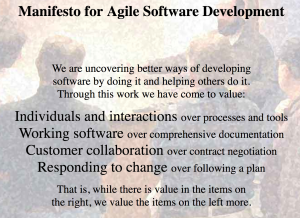Of course, any discussion of Agile values starts with the Agile Manifesto. The first sentence declares that Agile development is about seeking better ways and helping others. Then, as if espousing self-evident truths, the founders present four relative value statements. Finally, they emphasize appropriate balance, saying that the relatively less valued items aren’t worthless: implying that they are to be maintained inasmuch as they support the relatively more valued items.
 While there is value in the four relative value statements, I believe most successful Agilists value the first and last statements more. So to me, the core Agile values are continuous improvement, helping others, and balance.
While there is value in the four relative value statements, I believe most successful Agilists value the first and last statements more. So to me, the core Agile values are continuous improvement, helping others, and balance.
There’s a lot written about Agile behaviors, but as I read most is geared toward scrummasters or managers, and most is about transitioning from the waterfall world. Starting from the premise that Agile methods are established, focusing on participants rather than managers, and based on the assumption that behaviors are grounded in values, this post details the values and behaviors I’ve observed of those who succeed as Agile team members.



 As I mentioned in the
As I mentioned in the 

 As you’ve read on this site and many others, the database world is well into a transition from a relational focus to a focus on non-relational tools. While the relational approach underpins most organizations’ data management cycles, I’d venture to say that all have a big chunk of big data, NoSQL, unstructured data, and more in their five-year plans, and that chunk is what’s getting most of the executive “mind share”, to use the vernacular.
As you’ve read on this site and many others, the database world is well into a transition from a relational focus to a focus on non-relational tools. While the relational approach underpins most organizations’ data management cycles, I’d venture to say that all have a big chunk of big data, NoSQL, unstructured data, and more in their five-year plans, and that chunk is what’s getting most of the executive “mind share”, to use the vernacular.
